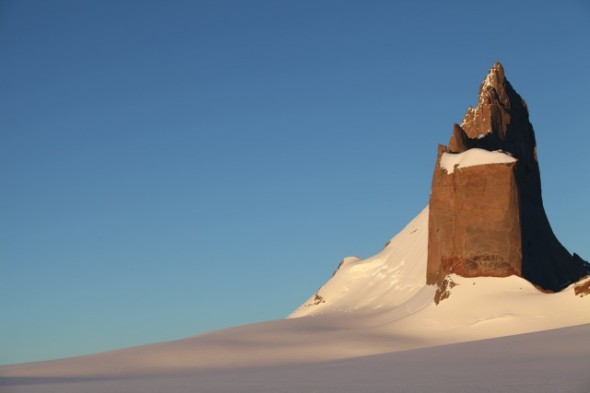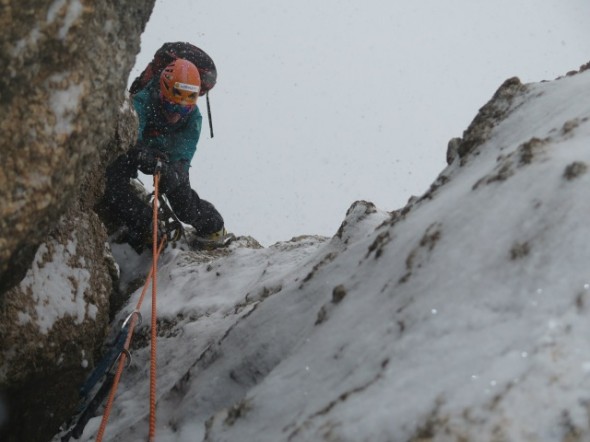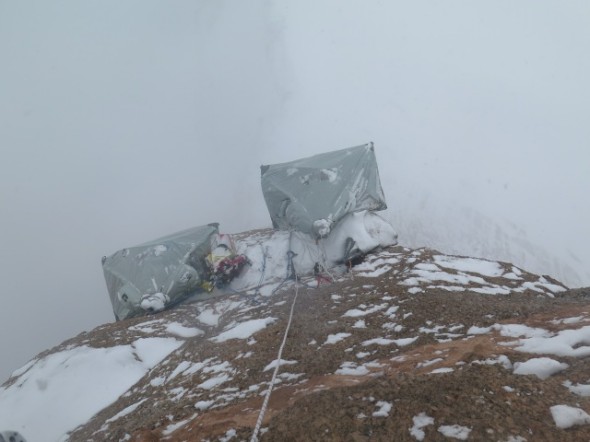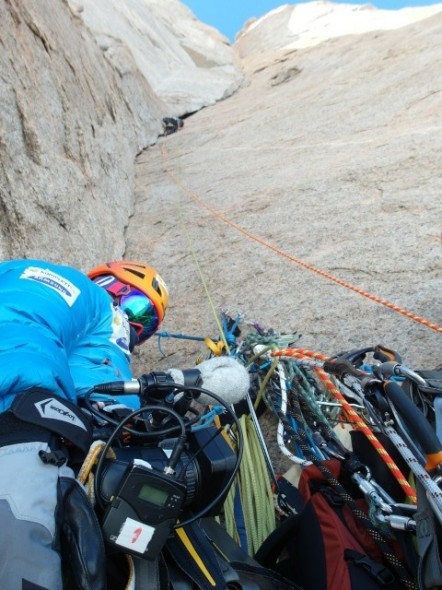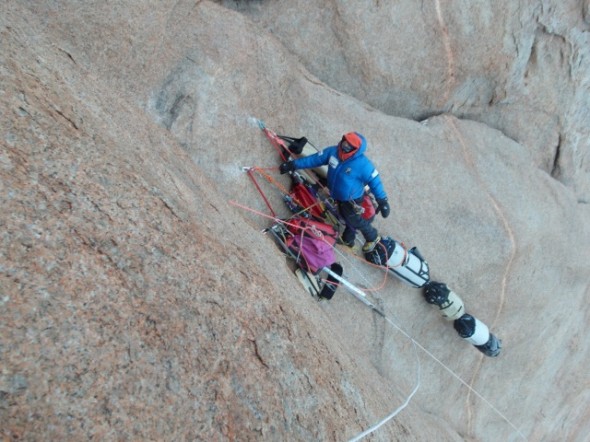T&M columnist Andy Kirkpatrick files a report from Antarctica about his latest adventure, which involved big wall climbing and base-jumping…
I was in the climbing doldrums, a trip to the towers of Paine cancelled, no sign of enough work to fund any future adventures, when one evening an email popped up on my phone: “Andy. I think I have a big project for you. Queen Maud Land. Departure 15 Dec, need you, all costs on me, TV series, two months. Multi-sport adventure with climb and base and first ascents. Are you in?”
The mail was from the legendary Norwegian all-rounder Aleks Gamme (pro skydiver, longest polar trip in history solo to and from the South Pole, Everest, etc), who I’d climbed the Troll Wall with that winter. It was one of those emails which you dream of getting one day, but which when you do, you wonder if you really have the will (or the balls) to say yes. I looked up at my kids. “Ella, Ewen, I’ve been asked to go to Antarctica for two months. If I go I’ll miss Christmas”.
They both moaned out a long ‘noooooooo’.
“It’s with Aleks Gamma”.
“Really!?” they both replied, having seen Aleks in the awesome film ‘Crossing the Ice” at Kendal the year before. “Oh you have to go if Aleks has asked”.
And so I did.
I turned up in Norway in mid-December and met the rest of the team. Two base jumpers Kjerski Eide and Espen Fadnes, a camera woman Ingerborg Jackobson, an 8a+ sport and ice climber called JJonas Langseth, and Aleks. I was still unsure just what we had planned, but it seemed that it would involved base jumping, speed riding, climbing and pulling pulks in order to explore the range. I felt a little guilty, as living in another country I had done virtually no work on the trip. All I could hope was I’d pay my way once we got to the mountains.
The long journey South began in Oslo, stopping at Heathrow, Cape Town, then onto the Russian base at Novo close to the coast of Antarctica (where we were stuck for five days in a storm), then to our final destination via Twin Otter. We were dropped on into the middle of the ‘Tongue’ of the famous circe of walls and spires, set in the shape of a wolf’s teeth, a dreamland for any big wall climber. As the plane lifted off, leaving us alone beside a mountain of kit, and the sound of its engines faded, a silence rushed in that was so total that its oppressiveness was almost too much to bare (several times, on the hardest days, I hallucinated the sound of traffic). Base camp built, we tried to get to grips with being here, and make sense of our objectives, and most of all the juggling of competing projects.
Almost immediately cracks appeared in the team. They say never to go on a trip with a soloist, and from the start of the trip I seemed to be bumping heads with Jonas. I had great respect for him as a climber, a nurse, and as a guy who’s strength and ability was always in demand (he was in the Norwegian special forces, and was one of the strongest climbers I’d climbed with) – but as a climber of cold, loose and dangerous rock, I just found I could not find that subtle connection, were I felt safe climbing with him (he had climbed the Troll at the age of 17, but even that was no enough for me). To be fair I was an asshole, and suspect the more I focused myself on testing and questioning Jonas, the more and more doubt he felt about himself. I found myself shouting at him many times, or using harsh words and thoughts. I guess I knew that our objectives would require the ultimate level of skill in hard super alpine/big wall climbing (rock like ‘cornflakes’, minus thirty temperatures, no chance of rescue from the wall), and although a strong and bold climber I made a judgement early on that I could not share the burden of leading with Jonas. This thinking – real or not – caused a great deal of trouble and stress, but somehow, Jonas and I found a way to either overcome or ignore these problems and climb together.
I think I had also put Espen and Kjersti in a box in my head labelled “selfish fun seekers”, they types I’d met so many times in Chamonix. For them life was about having short term fun. Hiking a mountain to jump off for 10 seconds of base thrill, or being dropped off by a helicopter to swoosh down through the ‘pow’. They were good looking, had great clothes (teeth, hair etc) and I felt little in common with them. In fact I know I was just jealous. I was overweight, felt none of my free clothes fitted me, and was out of shape for this trip. Worst of all I had long since lost any interest in ‘just having fun’, and when they questioned why everything had to be ‘hard and miserable’ I felt stung. I said they where childish and didn’t understand what true happiness was, saying that surfing in on the perfect wave with a naked woman on your shoulders was not going to lead to enlightenment. And then I wondered if I was in fact wrong, that these two had it right. And then I saw some footage of Kjersti base jumping with a wing suit in Interlaken, a flight that seemed to take forever, soaring down through chasms and along walls, over trees (and in-between trees). As soon as the video stopped I think my respect for her had grown a thousand times. This was no base princes. This woman was hardcore. Then I a picture of Espen base wind suit flying under the bridge that connects the two sides of the Midi. Maybe their idea of fun was no so different to mine.
After a five day trip to climb the highest mountain in the range (we ended up making the first ascent of the wrong one!), we set to climbing our first wall, a pillar and face on the West face of Holstinnd. This route took about 10 days in very poor weather (a lot of snow), and comprised primarily of 10 rope stretching pitches (most close to 60 metres), ranging from dangerous A4 (loose, expanding and friable flakes, bat hooks in crumbling rock and beaks), Scottish 7 mixed climbing on the worst rock i’ve ever climbed on (like stale bread and old cheese), and a couple of off width chimney pitches that where so horrible I could only recommend this route to Stalin (I’ve always hated off widths, but luckily I’d watched ‘Wide Boys’ not long before I left, and so ended up using a few things I’d learned – do so many arm bars that I wore out the elbow of my jacket – I also learned that a Camalot 6, although big, still leaves quite a gap between where you can aid, and where you can chimney!).
The route completed with Jonas, I gave it the name Zardoz (named after the triply sci-fi film with Sean Connery, that features and big stone head that people worship). The route was climbed capsule style from one portaledge camp, and all belays had one 10mm bolt (my Petzl drill snapped on the 3rd bolt, and so I was forced to use a Hilti drill we’d brought along under my protest). No protection bolts where placed, but a dozen or so ‘bat hook’ holes where drilled, as no edges would take a hook without breaking (several hooks blew even when using hooks). I took one 10 metre fall from the crux when a Tomahawk ripped after hanging on it for 10 minutes (rock fell apart), and was held by two stacked beaks lower down.
The first route in the bag we set off for a second adventure trip, heading over to the mountains to the West, where Kjersti and Epsen made a rare base jump from an unclimbed mountain (the trip up and down took us 24 hours).
So far we’d had some very cold days (sub 30 and colder), and began to understand that here in Antarctica everything is longer, higher, harder, colder and more extreme than it first seems. Very soon our stock phrase became T.I.A – which instead of standing for ‘This is Africa’ stood for ‘This is Antarctica’.
Now we switched as a whole team to our final, and major objective, the unclimbed South Ridge of Ulvertanna. This route had been attempted at least 3 times (spanish, French military expedition and Robert Caspersan), which each team getting closer and closer to the top. The route comprised of a 300 metre big wall (a medium to wide crack on good rock, with bolt belays, and re-belays), then a long technical ridge on loose rock (ranging from loose, to LOOSE!!!). All other teams had fixed the wall section, then tried to reach the summit in a push. These teams had been small elite teams who had been able to depend on a great deal of experience. Robert Caspersan had been the highest, just three pitches from the top, but then Robert had already made two first ascents on the mountain, so knew its moods well. In fact Robert had a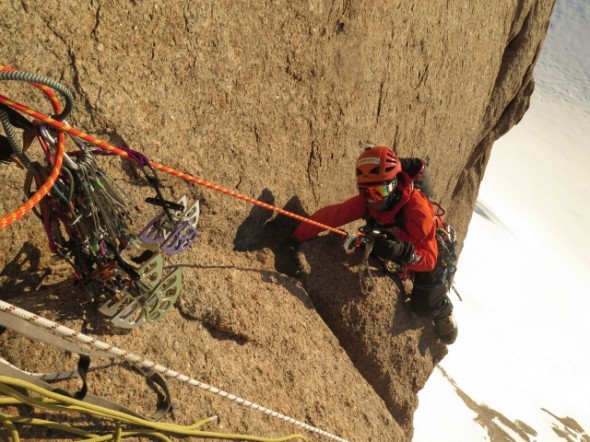 sked us not to try the route unless we chose the purest style – no bolts – ground up – in a push. I considered it for a moment, knowing that Robert was right, to climb such a jewel (perhaps one of the greatest unclimbed big wall lines around) was the ideal. But then no other route had been climbed like this. All others (Roberts, the Hubers, Leo Houldings) had been climbed capsule style (fixed ropes, bolts etc). Also I felt that the burden of the climb would rest on my shoulders, and that if we were to get six climbers on the summit at the same time, and climbing in Jan/Feb, we would have to employ those same tactics.
sked us not to try the route unless we chose the purest style – no bolts – ground up – in a push. I considered it for a moment, knowing that Robert was right, to climb such a jewel (perhaps one of the greatest unclimbed big wall lines around) was the ideal. But then no other route had been climbed like this. All others (Roberts, the Hubers, Leo Houldings) had been climbed capsule style (fixed ropes, bolts etc). Also I felt that the burden of the climb would rest on my shoulders, and that if we were to get six climbers on the summit at the same time, and climbing in Jan/Feb, we would have to employ those same tactics.
And so I made a plan to climb the route in phases, climbing and on the job training for Kjersti and Espen when we climbed the bottle together (teaching someone to jumar, clean and haul on an Antarctic wall is one of the craziest things I’ve done). The crux of phase one was hauling a few hundred kilos of food, fuel, camping stuff (enough for 6 people for 14 days) 300 metres up the wall. On that day we where working for 24 hours, the end of which saw us literally crawling up to our camp dragging our bags.
The next day Aleks and Jonas arrived, bring up our fixed ropes to use on the upper route (and so making escape back down to camp impossible without a total retreat). The idea was Jonas, me and Aleks would now climb the upper ridge, and once we where on the summit, Kjersti and Espen would base jump, but within one day Jonas came down with food poising from eating some dodgy mince at base camp. And so we mixed and matched, until after about 13 days since beginning I climbed the second to last pitch – up a mind blowing horn of rock pasted with wind sculptured rock on one side. I was unsure if I could free climb up this feature, as any object sticking from the rock invariability snapped off when pulled on, but half way up I found a worn hole going through the rock spire and managed to squeeze through (I got my weight up to 100kg before the trip, and lost 15kg in 50 days, so it was lucky this feature was encountered at the end, not the start of the exped). Once through I climbed up a snow ramp and pulled onto a tiny flat area and saw the summit for the first time, just 30 metres away (an easy scramble). The goal had always been for us all to reach the summit together, and I had experienced a real sense of pride at how well the team had worked together, learning new skills, and often putting aside their personal ambitions. I could have so easily climbed up and bagged the summit, but instead knew I had to wait until tomorrow.
Back at the tent on the shoulder I was shattered, and wondered how I could jug all the way back in the morning, but Aleks said we should wait one day, then jumar up at 2am, so Kjersti and Espen could jump the wall. If they jumped, this would go down as one of the greatest jump/climbs off all time (I often chuckled how crazy the whole project). In the morning I said to Espen, one of the worlds best base jumpers “the most important thing is that you jump”, to which he replied “No – the most important thing is that we all get to the top together”.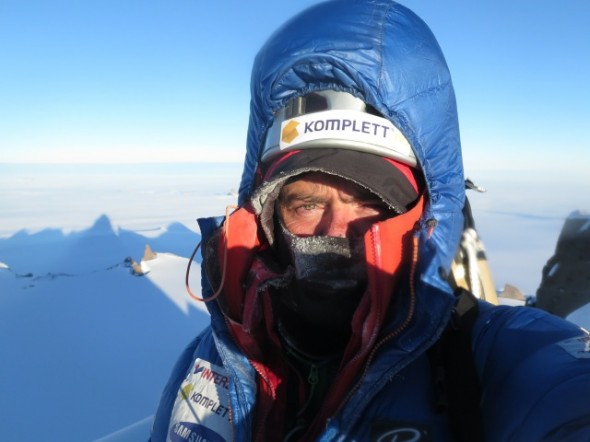
It was tense waiting in the tent, drinking tea, hoping we would all be safe jugging up our fixed ropes one more time (the ridge involved some complex terrain, meaning going up and down involved abseiling and jumping).
Then at 7am Aleks stuck his head in the tent. “Guys bad news, I’ve just talked to Oleg at Novo. There is a storm coming. He says we will be OK, and I told him we were not at base camp, but high on Ulvertanna, and he said ‘We must get down”. Through out the day cloud had built up around the mountains where we had been forecast clear weather for one more day, giving me a slight feeling of dread. I knew that having a day off had not been my idea, and had been the first divergence from ‘the plan’, but after so many days climbing my body was falling apart (all my fingers and toes had lost all sensation, and I had mild frostbite on my nose and cheeks caused from having my body wedged in so many sunless cracks and chimneys).
The idea of the Russian hard-man at Novo telling us to get down was worrying. Several times I had been trapped on walls in storms and feel that each time I had been lucky to survive. Here, with this team, in an antarctic storm, someone, maybe all of us, may not make it down – well not with all our fingers, toes and noses.
“I think we should set off now” I said, fearing that now the clock was ticking. We had to hope we had time to climb to the top (4 hours), then clean the upper route, in order to fix the lower wall to get off the mouton. It was a tall order, and was going to require no sleep this day, and working into the rest of tomorrow.
“I also think you guys cannot jump” said Aleks. No one spoke. Then Espen asked why, and some reasons where given; splitting up the team, the need for us to have both satellite phones, the fact they would land on the wrong side of the mountain with no support. I could tell Espen was shocked that this dream could falter now we were so close. “What does Andy think?” and all eyes where on me. I didn’t want to one to make such a choice, but in my heart of hearts I knew that I had grown to respect these two base jumpers, their ability to think through problems, to be dependable and reliable (to just do what I asked to do, and in the way I wanted). If a storm came I needed them here. Also, perhaps selfishly, they were no longer just ‘base jumpers’, they were friends who I had grown to care for and I was scared that this crazy climb could so easily become an awful tragedy. “I would like it if you came down with us” I said, and Espen just said “OK”, and said they would not even take there base rigs up, so as to eliminate temptation to jump.
And so, after a meal, we each set off twenty minutes apart and started up the fixed ropes. As we gained height the cloud began to clear, and I had one of those “Oh fuck” moments, knowing the guys could have jumped. After a few hours I arrived at the final pitch, the others forming up one by one behind me as I led the last loose snow and rock up to the summit pyramid. True to the mountain even the last few metres felt serous and bold, rock lumps the size of footballs crumblings and falling away as a moved up without any pro. And then I was there. A summit with large fractured pinnacle, that I looped with the rope to stop me falling off, and then used myself as an anchor to allow the other to jumar up.
We stood there, a new route on what has been called ‘the hardest mountain in the world’ (due mostly to its locality) and I think we all felt the same – flat and sad. If the guys had had their rigs they could have jumped. Conditions where perfect, and the exit was mind-blowing. I felt no cense of achievement at all. As with all summits all I wanted was to get the hell out of there.
Thirty six hours since waking I dragged myself back to base camp, so shattered by the retreat down the wall, that as I skied along it took all my concentration not to fall over, the sound of my pulk no longer the heavy swish of plastic on snow, the sound of cars, rivers, people talking. The only thing that kept me going was the knowledge that everyone had made it down alive (and with all their fingers and toes – we summited in Feb, with the sun setting, making the cold something to really fear).
Two weeks later, sitting in a boiling internet cafe in Cape Town (going from -30 to +30 in 6 hours is quite a change) I look back at the South Ridge and what we achieved as a team. Kjersti and Epsen repeatedly say “Oh we didn’t climb it, we just jumared it”, while Jonas feels sad that he led so little of the route (all the team apart from Ingerborg lead, hauled and cleaned on the route). I try and tell them that they are too young to this game of climbing mountains to understand what they have done, and that to sacrifice the greatest of dreams to stay close to your partners is someone more noble and worthy than any jump into cold space. I feel so proud of what we did, and what is possible with raw talent. In all these conversations, when I try to make them see what they have done, I always leave them with this final example. Apollo 11 went to the moon piloted by a computer, but they still went to the moon, and more importantly they all came back.
Andy Kirkpatrick is sponsored by Montane. For more information go to www.montane.co.uk


